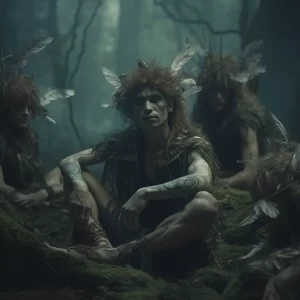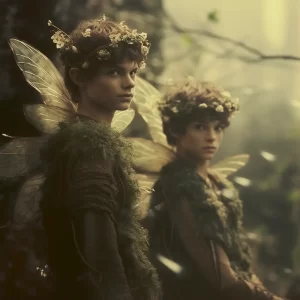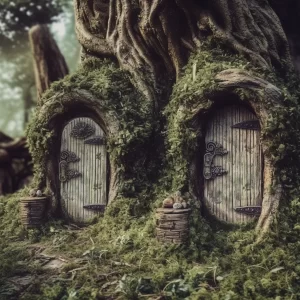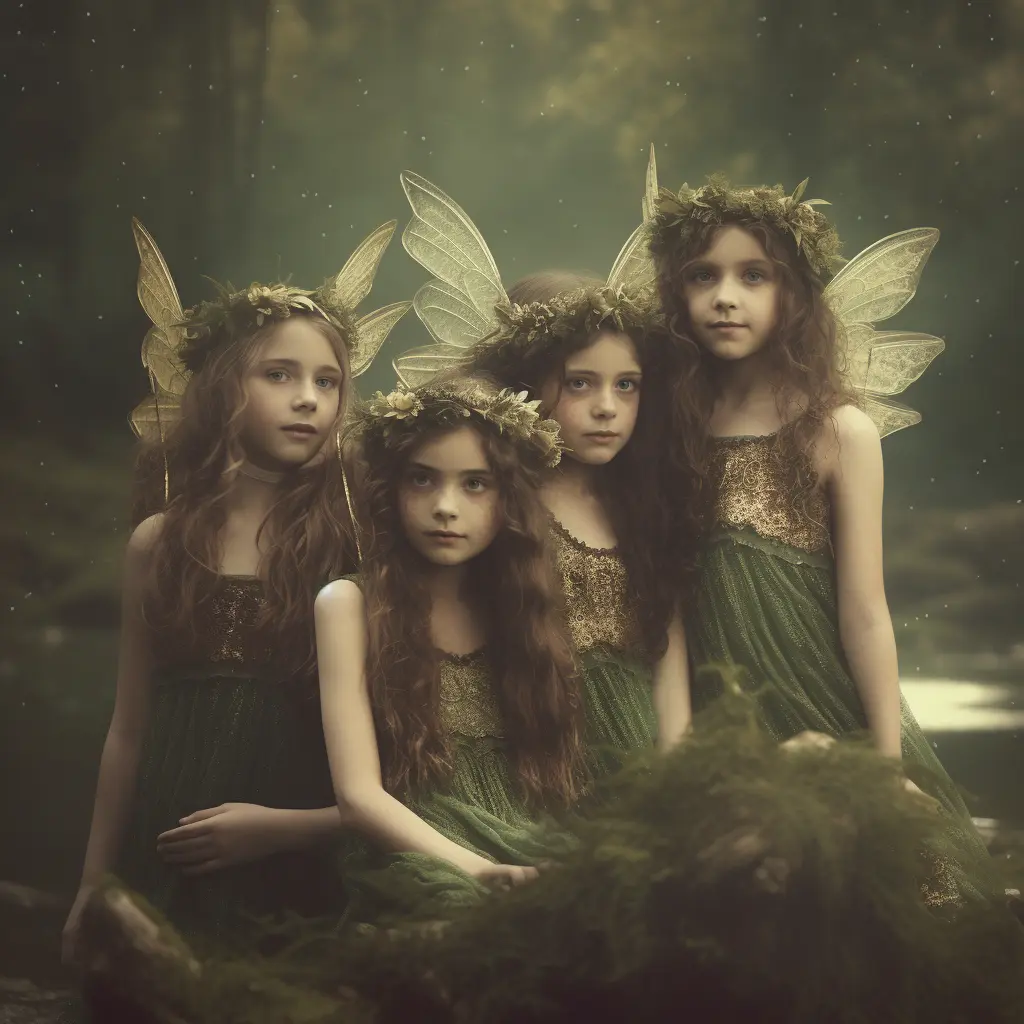Celtic Irish fairy tales and folklore have been passed down through generations, captivating listeners with their magical and mystical stories. These tales are deeply rooted in Irish culture and are an integral part of its history. They offer a glimpse into the beliefs and values of the people who told them, providing insight into the way they saw the world.
The stories often feature supernatural beings such as fairies, banshees, and leprechauns, who are typically mischievous and unpredictable. They can bring good luck or bad luck, and it is important to know how to appease them. Many of the tales also have a moral lesson, teaching listeners about the consequences of greed, pride, or other character flaws. The stories are not just entertainment but also serve as a way to pass down cultural values and wisdom.
What are Celtic Irish Fairy Tales and Folklore?
Celtic Irish Fairy Tales and Folklore are a collection of stories, myths, and legends that have been passed down orally through generations in Ireland. These tales are an integral part of Irish culture and are often associated with the country’s rich history and traditions.
The stories typically involve supernatural beings such as fairies, leprechauns, and banshees, as well as heroes and heroines who embark on quests and adventures. They are often set in a magical and mystical world that is closely intertwined with the natural landscape of Ireland.
Celtic Irish Fairy Tales and Folklore are not just entertaining stories; they also serve as a means of passing down cultural and moral values from one generation to the next. They are a reflection of the beliefs, customs, and traditions of the Irish people, and provide insight into their way of life and worldview.
Some of the most famous examples of Celtic Irish Fairy Tales and Folklore include the legend of Cú Chulainn, the story of the Children of Lir, and the tale of Tír na nÓg. These stories have been adapted and retold in various forms over the years, including in literature, film, and television.
The History of Celtic Irish Fairy Tales and Folklore

Celtic Irish fairy tales and folklore have a rich history that spans centuries. The roots of this tradition can be traced back to the ancient Celtic people, who believed in a fairy faith that was deeply intertwined with their daily lives. This faith was based on the belief that fairies, or “the Good People,” were supernatural beings that inhabited the natural world and could bring good or bad luck to those they encountered.
Over time, this belief in fairies evolved into a complex system of folklore and storytelling that was passed down through generations. Celtic fairy tales and folklore were often used as a way to explain natural phenomena, such as the changing of the seasons or the behavior of animals.
One of the most famous collections of Celtic Irish fairy tales is the “Lebor Gabála Érenn” or “The Book of Invasions” which tells the story of the mythical origins of Ireland. Other popular tales include “The Children of Lir,” “The Cattle Raid of Cooley,” and “The Táin Bó Cúailnge,” which are still widely read and studied today.
Despite the enduring popularity of Celtic Irish fairy tales and folklore, the fairy faith that inspired them has largely faded away. However, many people in Celtic countries still hold onto a belief in fairies and other supernatural beings, and these beliefs continue to influence modern culture and storytelling.
Types of Celtic Fairies

Celtic countries, including Ireland, Wales, and Scotland, are rich in folklore and fairy tales. Fairies, or “sidhe” in the Celtic language, are a common theme in these stories. These fairies are often depicted as mischievous, magical creatures who can bring both good and bad luck to humans.
There are many different types of Celtic fairies, each with their own unique characteristics and abilities. Some of the most traditional types include:
- The Banshee: A female spirit who is said to wail or scream to warn of impending death. She is often depicted as an old woman with long hair and a cloak.
- The Leprechaun: A small, male fairy who is known for his love of gold and mischief-making. He is often depicted as wearing a green suit and hat.
- The Pooka: A shape-shifting fairy who can take on the form of a black horse or other animal. He is known for playing tricks on humans.
- The Selkie: A fairy who can transform from a seal into a human. She is often depicted as a beautiful woman who is sought after by men.
- The Tuatha De Danann: A group of powerful fairies who were said to have ruled over Ireland before the arrival of humans. They were known for their magical abilities and their connection to the land.
These are just a few examples of the many types of Celtic fairies. Each type has its own unique characteristics and abilities, and they all play an important role in Celtic folklore and mythology.
Famous Celtic Fairy Tales

Celtic fairy tales and stories have been passed down through generations, captivating audiences with their enchanting characters and magical worlds. Here are some of the most famous Celtic fairy tales and stories:
1. “The Children of Lir”
“The Children of Lir” is a classic Irish fairy tale that tells the story of four siblings who are turned into swans by their jealous stepmother. The siblings spend 900 years flying around Ireland, enduring many challenges and hardships, before finally being released from their curse.
2. “The Selkie Bride”
“The Selkie Bride” is a Scottish fairy tale that tells the story of a man who falls in love with a seal who transforms into a woman on land. They marry and have children, but when the man steals the seal skin, the selkie is forced to return to the sea.
3. “The Fairy Queen of Spencer’s Butte”
“The Fairy Queen of Spencer’s Butte” is an American fairy tale that was inspired by Celtic folklore. The story tells of a young boy who is taken to the fairy queen’s court and must complete a series of tasks to earn her favor.
4. “The Brownie of Blednock”
“The Brownie of Blednock” is a Scottish fairy tale that tells the story of a helpful brownie who assists a farmer with his work. The brownie is rewarded with a new suit of clothes, but when he realizes that he has been tricked, he disappears forever.
These are just a few examples of the captivating Celtic fairy tales and stories that have enchanted audiences for centuries.
Celtic Fairies in Mythology and Folklore
Celtic fairies are an integral part of Irish mythology and folklore. These supernatural beings are known for their mischievous and unpredictable nature and are deeply ingrained in the cultural fabric of Ireland.
In ancient Celtic mythology, fairies were believed to be the spirits of nature, inhabiting the forests, rivers, and mountains. They were often associated with fertility, growth, and abundance, and were revered as protectors of the natural world.
Celtic fairy lore is rich with stories of encounters between humans and fairies. These tales often depict fairies as capricious and unpredictable, capable of both bestowing blessings and wreaking havoc on those who cross their path.
Celtic fairy goddesses, such as Aine and Cliodhna, were revered as powerful figures in Celtic mythology. Aine was associated with the sun, fertility, and the harvest, while Cliodhna was known as the queen of the banshees, a type of fairy that foretells death.
Celtic women were often associated with fairies in folklore, with stories of women being abducted by fairies and taken to the fairy realm. These tales often served as cautionary tales, warning women to be wary of the dangers of the fairy world.
Celtic Fairy Magic and Symbols
Celtic fairy magic is deeply rooted in Irish folklore and mythology. It is believed that fairies, also known as the Sidhe, are powerful beings that can bring good fortune or misfortune to those they encounter. Celtic fairy symbols are often used as a way to connect with these magical creatures and harness their power.
One of the most common Celtic fairy symbols is the four-leaf clover. It is said that finding a four-leaf clover brings good luck and protection from fairies. Another popular symbol is the horseshoe, which is often hung above doorways to ward off evil spirits.
In addition to symbols, there are many rituals and spells that are used to invoke fairy magic. One such ritual involves leaving offerings of milk and honey for the fairies. This is believed to appease them and bring good luck to the household.
Another powerful ritual involves creating a fairy circle. This is done by making a ring of stones or flowers in a secluded area. It is believed that fairies will be attracted to the circle and will bless those who enter it with good fortune.
Celtic Fairy Doors and Trees

Celtic fairy doors and trees are an integral part of Irish folklore and are believed to be portals to the fairy realm. These doors and trees are often found in gardens or near homes, and it is believed that fairies use them to enter and exit our world.
Celtic fairy doors are small, decorative doors that are often placed at the base of trees or in gardens. They are typically made of wood and are intricately designed with small details such as hinges, doorknobs, and even windows. It is believed that these doors are used by fairies to enter and exit our world, and some people even leave small offerings such as food or coins for the fairies.
Celtic fairy trees are also an important part of Irish folklore. These trees are believed to be sacred and are often decorated with ribbons or other small items. It is believed that fairies live in these trees and that they provide protection and good luck to those who respect them. It is also believed that cutting down a fairy tree can bring bad luck and misfortune.
Irish fairy trees are similar to Celtic fairy trees and are also believed to be home to fairies. These trees are often marked with a white or red ribbon and are considered to be sacred. It is believed that if someone disrespects an Irish fairy tree, they will be cursed with bad luck.
Frequently Asked Questions
What are some famous Irish fairy tales?
Some of the most famous Irish fairy tales include “The Children of Lir”, “The Cattle Raid of Cooley”, “The Táin Bó Cuailnge”, and “The Wooing of Étain.”
Who are the characters in Irish fairy tales?
Irish fairy tales often feature characters such as fairies, leprechauns, giants, witches, and heroes. These characters are often used to teach moral lessons and to entertain.
What are some short Irish folk tales?
Some short Irish folk tales include “The Three Wishes,” “The King with Donkey’s Ears,” “The Giant’s Causeway,” and “The Leprechaun’s Gold.”
What are some famous Celtic fairy tales?
Some famous Celtic fairy tales include “The Mabinogion,” “The Book of Invasions,” and “The Four Branches of the Mabinogi.”
Are there any Irish bedtime stories?
Yes, there are many Irish bedtime stories that are perfect for children. Some popular ones include “The Story of Oisín,” “The Hound of Ulster,” and “The Salmon of Knowledge.”
What are the fairies in Irish folklore called?
The fairies in Irish folklore are often referred to as the “sidhe” or “shee.” They are believed to be supernatural beings that live in a parallel world and are often associated with nature and magic.

